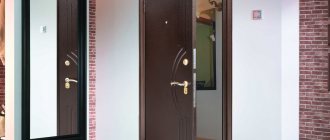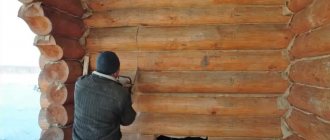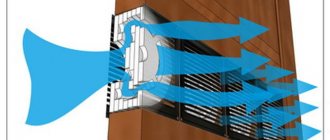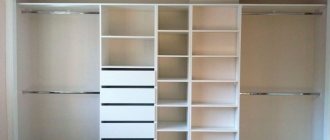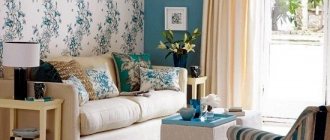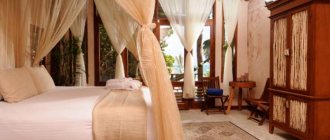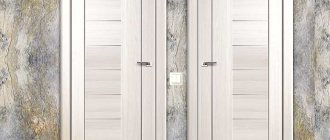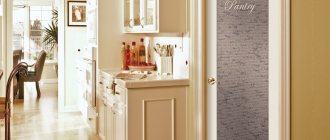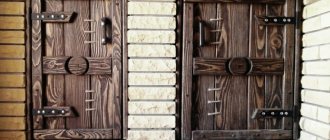Features of the decor of entrance doors
Doors, the outer part of which faces the entrance or the street, are subject to the influence of negative factors, in particular, changes in temperature and humidity. And we shouldn’t forget about the likelihood of physical damage from vandals. So, what options should you choose for decorating your front doors yourself?
Powder coating is recommended for metal structures. The surface of the doors is treated with a specialized compound. It heats up to a predetermined temperature, and then cools and transforms into a reliable and durable film. She is not afraid of physical and chemical influences.
Fans of experiments and non-standard solutions can give the front door the appearance of wild stone. To achieve the desired effect, you need to glue materials to it that imitate this texture.
The finishing material is an alloy of stone composite and acrylic. The surface decorated with this method is characterized by good strength and reliability. Even chemicals are not afraid of her.
If you need to finish the doors from the inside, then you don’t have to worry about strength and wear resistance. Pay attention to the aesthetic qualities of the finish. The materials are chosen so that the door fits harmoniously into the interior of the room.
Often, wood, leather (natural and artificial), plastic parts, and decorative film are used for interior decoration. Decorative panels are also suitable. They imitate various textures and materials. Therefore, owners can easily choose the best option. If the budget is limited and you need to find the most economical decor, then you can stick to regular door painting.
Finishing with laminate
Today this material is very often used for cladding. Laminate as a finishing material has many advantages.
It is chosen because of the following advantages:
- It imitates wood, but is much cheaper in price compared to natural wood.
- Laminate is not afraid of exposure to ultraviolet radiation, it does not fade and is not afraid of temperature fluctuations.
- The cost of the finishing material is low, everyone can afford it.
- Dust is invisible on the laminate; it practically does not settle on it.
- If you wish, you can purchase products that look like stone or any other material: there are no restrictions in decor and colors.
Laminate also has several disadvantages. So, this material is afraid of high humidity. Therefore, they cannot be used to decorate the exterior of a metal door in a country house. If, however, the panels are mounted on an external door, they must be covered with a special moisture-resistant film. Also, when finishing a door with laminate, it is quite difficult to insulate it.
Laminated planks come in different thicknesses from 6 to 12 mm; the larger it is, the stronger and better the coating. There are several classes of laminate. In apartments and country houses classes 21 and 22, as well as 23 are used. In non-residential premises (offices, government institutions) classes 31 or 32, as well as 33 are used. Along with the class, the wear resistance and impact strength of the material increases, but its price also increases significantly.
Also, when purchasing a laminate, you need to take into account its geometric parameters. If you choose strips 1.2 meters long, then you can sheathe a metal door with them, both vertically and horizontally.
Features and methods of finishing interior doors
Strength and wear resistance are also not important for these structures. Decorative characteristics come first. Interior doors can be the highlight of your interior.
The main thing is to approach their decor seriously and with imagination. If you are interested in decorating doors with your own hands, then we will consider the most effective and popular solutions.
How to do the work yourself and what is needed for this?
Facing Tools:
- PVC - glue or construction staples, knife or scissors for trimming, panels, sandpaper, decorative plastic corners or strips;
- eco-veneer - iron, film, sandpaper, nitro varnish, solvent, weight for the press;
- laminate - screwdriver, screws, strips, decorative corners, buttons, primer, putty;
- painting - paint and varnish composition, primer, putty, sandpaper, brushes, roller, even supports;
- MDF panels - screws, screwdriver, corners, putty and primer mixtures.
Finishing with various building materials has general instructions:
- preparation of the base;
- applying putty, primer;
- grouting a new layer;
- cladding;
- checking the canvas for ease of opening and closing.
Do-it-yourself finishing is a process in which you can show your imagination and feel like a professional. But it also requires accuracy, diligence, and patience. If you follow the instructions and recommendations, you can turn an ordinary door into a work of art.
Coloring - fast and cheap
If you plan to finish the doors with minimal financial costs and in a short time, then this method is preferable. To work you will need brushes, paint, and masking tape. With the help of the latter, parts that do not need to be painted are covered.
The workflow consists of several stages.
- Preparation. Remove anything from the door that interferes with the painting. Handles, decorative removable elements, etc. Glass inserts are closed with masking tape.
- Surface polishing. It is important that there are no defects or roughness on the door. The old paint, of course, needs to be removed. This can be done using a small spatula and sandpaper.
- Coloring.
When choosing a paint color, consider the original color of the door. It is recommended to use acrylic paints as they dry quickly. The room must be well ventilated.
Hallways 2020: TOP-200 photos of the best new products and modern design. Options for the ideal combination of color and style of furniture in the hallway- DIY stool: manufacturing methods and instructions for creating simple and stylish models (90 photo ideas)
- DIY cornice: a detailed description of how to design and decorate a stylish interior element (80 photos)
How and with what to decorate a wooden entrance door from the inside: ideas, options, tips, photos
- Specialized stores offer a wide range of entrance door blocks. The quality of the facing material of the door structure may not meet the high demands of apartment owners.
- And the seemingly strong entrance block becomes unusable ahead of schedule. Of course, the situation is easily fixable if the apartment owner has enough funds to completely replace this important structural element.
- However, not all citizens have this opportunity. In this case, options are considered for purchasing facing materials that imitate various textured surfaces: wood, marble, glass.
- The result of simple manipulations performed independently, without the involvement of specialists, will be a complete restoration of the entrance door structure, which has lost its presentable appearance.
Facing the entrance door with laminate
If you set out to update the entrance door block beyond recognition, then the material in our article will be useful to you.
Materials that are used to carry out the restoration of the entrance door structure.
The decor of the entrance door block is made using:
- Inexpensive leatherette
- Self-adhesive PVC film
- Veneer or laminate
- MDF panels (in construction stores there are various color variations of this material)
- Plastic
- Various overlays for wood
- paint layer
The door structure can be restored by applying a layer of paint.
All these materials are used to replace the entrance door structure that has lost its external luster.
How to make an original lining of the entrance door block?
- If the hallway is small, then an interesting design option would be a mirrored entrance door. Such cladding will cost a pretty penny, but will turn the old entrance block into a real exclusive.
- You can cladding a door structure at minimal cost by using a material such as laminate. This facing material is presented in construction stores in various texture and color options, which will provide an individual and attractive look to the entrance door structure.
What you should pay attention to when choosing a material for upgrading the entrance door structure:
- The material must be safe
- The facing material must be resistant to corrosion
- The cladding must retain its original appearance, despite significant temperature fluctuations
- The material for cladding must be selected in accordance with the interior design of the room, and also take into account the view from the outside.
- Today, the assortment includes various economical options for durable and presentable cladding, suitable for the restoration of door structures.
Standard door sizes
Modern material for covering door blocks meets quality standards and is fireproof. It can be installed in common areas.
To carry out the restoration of the old entrance block structure, we offer detailed instructions:
- We select the finishing material, having previously calculated the linear footage corresponding to the dimensions of the door structure.
- If you plan to repair or update door slopes, then their dimensions are included in the linear footage.
The next step is to prepare the tools. To work you will need:
- simple pencil
- screwdriver
- sacral screwdriver
- pliers
- Bulgarian
- brushes
- glue
Before the restoration begins, the door leaf is removed from the hinges and installed on a horizontal plane.
Instructions for lining the entrance door block with laminate
- At the beginning of the work, we will remove the outdated door structure from the fastening elements.
- Place the door on a flat surface.
- We dismantle the handles, existing rim locks, and the peephole. It is important that before starting restoration, the surface of the door is free of protrusions.
- We take measurements of the door, taking into account the dimensions of the door leaf itself and the slopes.
- We cut the facing material (laminate) in accordance with the previously taken measurements.
- We fix the laminate board with liquid nails. To do this, we apply the facing material evenly to the surface of the door and the walls that form the slopes.
- If you plan to finish the door surface with scraps of laminate boards, then cut out geometric shapes of the desired sizes (squares, triangles).
- Laminate panels are installed on the restored door surface and on slopes without gaps.
- Using a jigsaw, holes are cut out for the lock, door peephole and handles.
- The auxiliary parts of the entrance door structure are installed: a lock, a peephole and door handles.
- The input block is installed in the box. When facing with laminate, there is no need to paint the door block.
- Laminate boards are quite wear-resistant. Therefore, when covering the door surface with this material, you can count on the fact that the excellent appearance and quality will be preserved for a long time. The main condition for this is careful handling.
A repaired door requires replacement hardware
Using laminate for cladding a door block
Cladding slopes with laminate is carried out in several stages:
- The door leaf is removed from the fasteners.
- The working surface is leveled and sanded.
- Cracks and gaps in the slopes are sealed, paint is applied to the door, after which varnish is applied to the dried layer of paint.
- After all the steps described above, a polyurethane composition is applied to the working surface.
- When the door leaf has dried, you can drill holes for the fittings and fasten the missing door elements.
Facing slopes
How to restore a door entrance block with MDF panels
- We remove the door leaf from the fasteners.
- As with laminate cladding, we clean it with sandpaper.
- Apply a layer of solvent to degrease the surface.
- We prepare holes for subsequent fastening of the panels. We drill them around the perimeter of the door leaf and install frame strips on the slopes.
- We fix the MDF panels. We use liquid nails for this. To secure the facing material on the slopes, we use self-tapping screws.
- We fix the corners on the door and on the slopes.
- Apply putty to the work surface.
Restoration work to restore the entrance door block includes the use of putty to level the surface
MDF door cladding
Other methods of cladding the entrance door block:
- To restore a metal door structure, it will be enough to simply cover the canvas that has lost its former luster with paint.
- Another simple and inexpensive way to cover the front door is to apply liquid wallpaper. Fans of vintage style should pay attention to such cladding methods as buckwheat decor and mirrors.
There are other options for cladding the entrance door block. For example, using liquid wallpaper. Sequence of actions for cladding:
- The door is removed from the fastening elements.
- The old paint layer is removed.
- Putty is applied to the resulting holes and chips. The surface of the door leaf is treated with sandpaper.
- Next, an alkyd primer is applied to the canvas. It will ensure reliable adhesion of the surface of the door and slopes with liquid wallpaper.
- The working surface is sealed with white putty.
- The dry component of liquid wallpaper is diluted with warm water with the addition of the desired color.
- The resulting composition is infused for 8 hours, after which it can be applied to the door leaf and slopes. The mixture is scooped up with a spatula and stretched in different directions. It is necessary to ensure that no distortions occur while fixing the liquid wallpaper.
- Next, the door is processed with a textured roller. This manipulation will ensure a tight fit of the liquid wallpaper to the surface of the door, and will also create the desired texture.
- A transparent varnish is applied to the dry work surface.
Before starting work, the door is removed from its hinges
Painted entrance doors
Varnish finish
This decorative door finish is ideal for structures made of natural wood, which have an attractive texture and interesting wood pattern. Another easy and budget option available to everyone.
We pre-prepare the surface. Everything here is the same as before painting. We use sandpaper, remove roughness and achieve a perfectly smooth surface. Then we apply varnish. The tree quickly absorbs it. Therefore, it is recommended to apply the finishing material in 2-3 layers.
To simplify the work, it is advisable to remove the door and lay it horizontally. We remove the fittings, close the glass and other decorative inserts.
Finishing the doorway, extensions and panel materials
Extensions and various panels can be called classics of the genre of doorway design - the first of them (extensions), due to their small width, are the best option for openings equipped with doors, and the second (all kinds of panel materials) are excellent for finishing an opening without doors, as well as for openings equipped with them. Let's take a closer look at both options.
- Finishing doorways with extensions. What are extras? In essence, this is a thin strip, which in the standard version has a width not exceeding 250mm. It can be made from any sheet materials, but in most cases it is MDF, plywood and, in rare cases, natural wood. If you have a strong desire and the presence of a certain tool, it is enough to simply make an additional strip with your own hands - saw the material and decorate it at your discretion. The installation of extensions is also quite simple - you can read about this in the article “Extensions for doors”.
- Finishing doorways with MDF and other panels. By and large, finishing doorways with panels is not much different from the previous method - the only exception is the capabilities of this material. If the additions are able to change the visual perception of the door frame only slightly, then the panels allow you to do this in the best possible way - with the help of panels, especially if we talk about material equipped with tongues, you can decorate an opening of unlimited width. In most cases, they are simply assembled from separate slats according to the principle of connecting laminate panels, which, if necessary, can also be safely used for finishing interior doorways with or without doors.
There are two technologies for installing door panels and panels in the opening - in the first case, they are secured using polyurethane foam with low polymerization pressure, and in the second situation, frame technology is used. The latter technology is more acceptable when finishing wide doorways - for example, this could be a vestibule between the entrance doors of a private house, in which the thickness of the external walls can reach 800mm.
You can learn expert advice on finishing doorways from this video.
Adhesive tape
This option cannot be called practical, but it is still very popular. Everything here is extremely simple. We select a suitable decorative film and carefully glue it to the door.
The advantage of this method is that the surface does not need to be pre-prepared. Just wipe off the dust.
DIY folding chair: 110 photos, drawings, diagrams and sketches of convenient and easy options for creating portable chairs- Do-it-yourself pouf: step-by-step instructions on how to build a stylish and original interior element with your own hands (105 photos)
- Do-it-yourself folding table - step-by-step instructions for building and decorating a stylish design (80 photos)
Thanks to the large assortment of decorative films, you can easily choose an option for a specific interior. Look online for photos of door finishing with film. This will allow you to find a lot of non-standard and stylish solutions.
